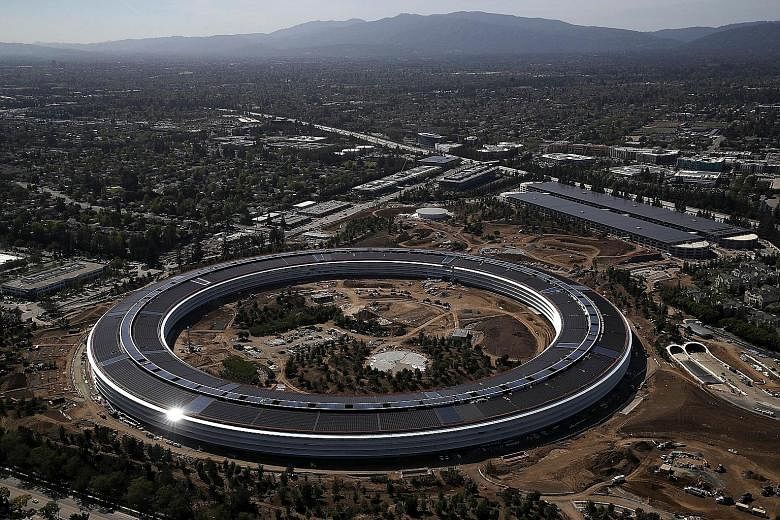CUPERTINO (California) • Things change when a spaceship comes to town. Tourists stroll by, whipping out iPhones to get a photo. New businesses move in. And real estate prices go up even more.
Apple's new home in Cupertino - the centrepiece being a US$5 billion (S$7 billion), four-storey, 2.8 million sq ft ring the size of more than 30 football fields that locals call the spaceship - is still getting some final touches and employees have just started to trickle in.
The full squadron, about 12,000 people, will arrive in several months.
But the development of the headquarters, a 71ha area officially called Apple Park, has already helped transform the surrounding area.
In Sunnyvale, 95 development projects are in the planning stages. A Main Street Cupertino living and dining complex opened last year. This downtown enclave includes the Lofts, a 120-unit apartment community opening in autumn.
A Residence Inn in Main Street Cupertino, expected to open in September, has been customised to meet the needs of Apple employees. Guests will have access to Macs and high-speed Internet connections.
Tech companies are nothing new for Cupertino. Apple has called the city home for decades. And Hewlett- Packard had a campus in Apple's new spot, employing 9,000 people.
The surrounding towns have been remade as well in the last decade, as giant tech companies have turned Silicon Valley's real estate into some of the most expensive in the country.
But city officials and residents say this project is like nothing they have seen before. It is even bringing tourists who snap pictures of the spaceship from the streets.
TV helicopters circle above. Drone operators want that coveted aerial shot while pedestrians want an eyeful of the glass building before it is hidden by a man-made forest.
The campus is one of the last major projects started by Mr Steve Jobs, the Apple co-founder who died six years ago.
A few months before his death, he went before the Cupertino City Council and laid out his vision for a futuristic circular house of glass that would foster creativity and collaboration. Two years later, the council approved the plans.
The main centre features the spaceship ring, the Steve Jobs Theatre, a 100,000 sq ft gym and a visitors' centre in a woodland setting with running and walking paths. An orchard and a pond are in the ring.
Not all of these changes have thrilled everyone. Residents of Birdland, an 877-home neighbourhood, have been particularly vocal. They have complained about earlymorning construction trucks that beep and rumble along major streets, unpredictable road closings and construction potholes.
The price of property in the neighbourhood has also become a source of some worry.
Sunnyvale and Cupertino, like many other Silicon Valley towns, have had an extended real estate boom. Prices in the area started to rise, real estate agents and residents said, after Apple released its plans.
A 1,400 sq ft, ranch-style house with three bedrooms that cost US$750,000 in 2011 has doubled in price. Since Apple said it was moving into the former Hewlett- Packard site, prices have moved up 15 to 20 per cent year after year.
Birdland is already drawing Apple employees, replacing home owners who have cashed out to move to quieter regions.
Apple's engagement of concerned residents will continue, said Mr Dan Whisenhunt, its vice-president of real estate and development.
"When you tell people what is upcoming, some of the anxiety they have calms down a lot," he added.
And, yet, he acknowledged: "You don't make everyone happy."
NYTIMES

